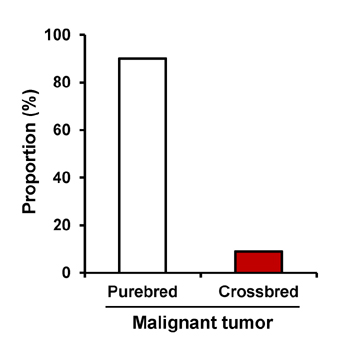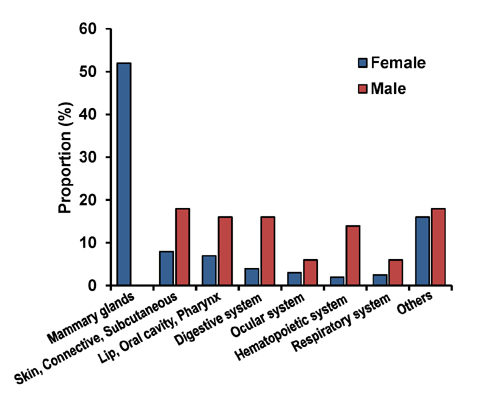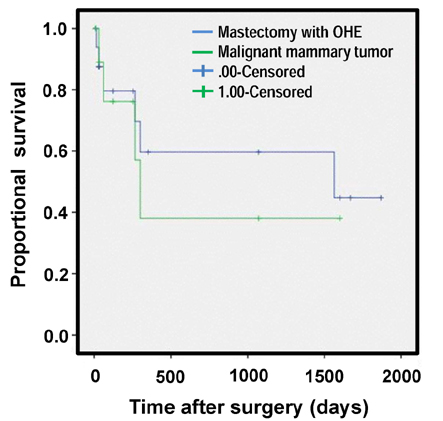Immune Netw.
2016 Apr;16(2):116-125. 10.4110/in.2016.16.2.116.
Clinical Outcomes of Surgically Managed Spontaneous Tumors in 114 Client-owned Dogs
- Affiliations
-
- 1Department of Veterinary Surgery, College of Veterinary Medicine, Konkuk University, Seoul 05029, Korea. swjeong@konkuk.ac.kr
- KMID: 2168052
- DOI: http://doi.org/10.4110/in.2016.16.2.116
Abstract
- Medical records of 139 tumors from 114 dogs that underwent surgery from May 2010 through March 2015 were retrospectively reviewed. Among 114 dogs, females (64.9%) were significantly more common than males (35.1%) (p<0.05). Dogs aged 6 to 10 years were more presented than non-tumor patients, however, there was no significant difference. The mean age (±SD) was 10.3±3.0 years. Although we found no significant difference of breed predisposition, the most common breed was Maltese (19.3%), followed by Shih-Tzu (14.0%), and Yorkshire terrier (13.2%). Proportional morbidity ratios (PMRs) of mammary gland, oral cavity, and skin tumors were high in Poodles, Yorkshire terriers, and Golden retrievers, respectively. Mammary gland (36.0%) was the most common site, followed by skin and soft tissues (12.2%), oral cavity (10.8%), and digestive organs (8.6%), but there was no significant difference. The objectives of surgery were curative surgery (86.2%), biopsy (4.9%), and palliative surgery (6.5%). In this study, 123 of 139 tumors had histopathological diagnoses. Adenocarcinoma was the most common type (n=24), followed by adenoma (n=17), soft tissue sarcoma (n=13), benign mixed tumor (n=5), and others (n=64). Recurrence or suspected metastasis was identified in 26 dogs. Median survival times of malignant mammary gland tumors, skin and subcutaneous tumors, and splenic tumors were 1,563.0±1,201.7, 469, and 128 days, respectively.
Keyword
MeSH Terms
Figure
Reference
-
1. Jemal A, Bray F, Center MM, Ferlay J, Ward E, Forman D. Global cancer statistics. CA Cancer J Clin. 2011; 61:69–90.
Article2. Siegel R, Ma J, Zou Z, Jemal A. Cancer statistics, 2014. CA Cancer J Clin. 2014; 64:9–29.
Article3. Fleming JM, Creevy KE, Promislow DE. Mortality in North American dogs from 1984 to 2004: An investigation into age-, size-, and breed-related causes of death. J Vet Intern Med. 2011; 25:187–198.
Article4. Inoue M, Hasegawa A, Hosoi Y, Sugiura K. A current life table and causes of death for insured dogs in Japan. Prev Vet Med. 2015; 120:210–218.
Article5. Misdorp W. Veterinary cancer epidemiology. Vet Q. 1996; 18:32–36.
Article6. Bronden LB, Flagstad A, Kristensen AT. Veterinary cancer registries in companion animal cancer: a review. Vet Comp Oncol. 2007; 5:133–144.
Article7. MacVean DW, Monlux AW, Anderson PS Jr, Silberg SL, Roszel JF. Frequency of canine and feline tumors in a defined population. Vet Pathol. 1978; 15:700–715.
Article8. Dobson JM, Samuel S, Milstein H, Rogers K, Wood JL. Canine neoplasia in the UK: estimates of incidence rates from a population of insured dogs. J Small Anim Pract. 2002; 43:240–246.
Article9. Merlo DF, Rossi L, Pellegrino C, Ceppi M, Cardellino U, Capurro C, Ratto A, Sambucco PL, Sestito V, Tanara G, Bocchini V. Cancer incidence in pet dogs: Findings of the animal tumor registry of Genoa, Italy. J Vet Intern Med. 2008; 22:976–984.
Article10. Vascellari M, Baioni E, Ru G, Carminato A, Mutinelli F. Animal tumour registry of two provinces in northern Italy: Incidence of spontaneous tumours in dogs and cats. BMC Vet Res. 2009; 5:39.
Article11. Bronden LB, Nielsen SS, Toft N, Kristensen AT. Data from the danish veterinary cancer registry on the occurrence and distribution of neoplasms in dogs in Denmark. Vet Rec. 2010; 166:586–590.
Article12. Pakhrin B, Kang MS, Bae IH, Park MS, Jee H, You MH, Kim JH, Yoon BI, Choi YK, Kim DY. Retrospective study of canine cutaneous tumors in Korea. J Vet Sci. 2007; 8:229–236.
Article13. Kim YH, Ahn NK, Roh IS, Yoon BI, Han JH. Retrospective investigation of canine skin and mammary tumors in Korea. J Vet Clin. 2009; 26:556–562.14. Dorn CR, Taylor DO, Schneider R, Hibbard HH, Klauber MR. Survey of animal neoplasms in Alameda and Contra Costa Counties, California. II. Cancer morbidity in dogs and cats from Alameda County. J Natl Cancer Inst. 1968; 40:307–318.15. Fritz A, Percy C, Jack A, Shanmugaratnam K, Sobin L, Parkin D, Whelan S. Fritz A, Percy C, Jack A, Shanmugaratnam K, Sobin L, Parkin D, Whelan S, editors. International Classification of Diseases for Oncology (ICD-O). 3rd ed.Geneva: World Health Organization;2013. p. 1–242.16. Cohen D, Reif JS, Brodey RS, Keiser H. Epidemiological analysis of the most prevalent sites and types of canine neoplasia observed in a veterinary hospital. Cancer Res. 1974; 34:2859–2868.17. Mitchell L, De la Iglesia FA, Wenkoff MS, Van Dreumel AA, Lumb G. Mammary tumors in dogs: survey of clinical and pathological characteristics. Can Vet J. 1974; 15:131–138.18. Moe L. Population-based incidence of mammary tumours in some dog breeds. J Reprod Fertil Suppl. 2001; 57:439–443.19. Todorova I. Prevalence and etiology of the most common malignant tumours in dogs and cats. Bulg J Vet Med. 2006; 9:85–98.20. Rivera P, Melin M, Biagi T, Fall T, Haggstrom J, Lindblad-Toh K, von Euler H. Mammary tumor development in dogs is associated with BRCA1 and BRCA2. Cancer Res. 2009; 69:8770–8774.
Article21. Pires I, Alves A, Queiroga FL, Silva F, Lopes C. Regression of canine cutaneous histiocytoma: reduced proliferation or increased apoptosis? Anticancer Res. 2013; 33:1397–1400.22. Butler M, Bonnett N, Page L. Epidemiology and the evidence-based medicine approach. In : Withrow SJ, Vail DM, Page RL, editors. Withrow & MacEwen's Small Animal Clinical Oncology. 5th ed. St. Louis, Missouri: Elsevier saunders;2013. p. 68–82.23. Ettinger SN. . Principles of treatment for canine lymphoma. Clin Tech Small Anim Pract. 2003; 18:92–97.24. Spodnick GJ, Berg J, Rand WM, Schelling SH, Couto G, Harvey HJ, Henderson RA, MacEwen G, Mauldin N, McCaw DL, Moore AS, Morrison W, Norris AM, O'Bradovich J, O'Keefe DA, Page R, Ruslander D, Klausner J, Straw RC, Thompson JP. Prognosis for dogs with appendicular osteosarcoma treated by amputation alone: 162 cases (1978-1988). J Am Vet Med Assoc. 1992; 200:995–999.25. Kuntz CA, Dernell WS, Powers BE, Devitt C, Straw RC, Withrow SJ. Prognostic factors for surgical treatment of soft-tissue sarcomas in dogs: 75 cases (1986-1996). J Am Vet Med Assoc. 1997; 211:1147–1151.26. Spangler WL, Kass PH. Pathologic factors affecting postsplenectomy survival in dogs. J Vet Intern Med. 1997; 11:166–171.
Article27. Wood CA, Moore AS, Gliatto JM, Ablin LA, Berg RJ, Rand WM. Prognosis for dogs with stage I or II splenic hemangiosarcoma treated by splenectomy alone: 32 cases (1991-1993). J Am Anim Hosp Assoc. 1998; 34:417–421.
Article28. Jermyn K, Duncan B, Lascelles X. Principles of oncological surgery. In : Dobson M, Lascelles D, editors. BSAVA Manual of Canine and Feline Oncology. 3rd ed. Quedgeley, Gloucester: BSAVA;2011. p. 44–59.29. Moore GE, Sandberg A, Schubarg JR. Clinical and experimental observations of the occurrence and fate of tumor cells in the blood stream. Ann Surg. 1957; 146:580–587.
Article30. Sugarbaker PH. Overview of peritoneal carcinomatosis. Cancerologia. 2008; 3:119–124.31. Park SY, Choi GS, Park JS, Kim HJ, Ryuk JP, Choi WH. Influence of surgical manipulation and surgical modality on the molecular detection of circulating tumor cells from colorectal cancer. J Korean Surg Soc. 2012; 82:356–364.
Article32. Atkin G, Chopada A, Mitchell I. Colorectal cancer metastasis: in the surgeon's hands? Int Semin Surg Oncol. 2005; 2:5.33. Romsdahl MM, McGrath RG, Hoppe E, McGrew EA. Experimental model for the study of tumor cells in the blood. Acta Cytol. 1965; 9:141–145.34. Nishizaki T, Matsumata T, Kanematsu T, Yasuaga C, Sugimachi K. Surgical manipulation of VX2 carcinoma in the rabbit liver evokes enhancement of metastasis. J Surg Res. 1990; 49:92–97.
Article35. Abgral R, Valette G, Robin P, Rousset J, Keromnes N, Le Roux PY, Marianowski R, Salaun PY. Prognostic evaluation of percentage variation of metabolic tumor burden calculated by dual-phase 18FDG PET-CT imaging in patients with head and neck cancer. Head Neck. 2016; 38:E600–E606.36. Morris JS, Dobson JM, Bostock DE, O'Farrell E. Effect of ovariohysterectomy in bitches with mammary neoplasms. Vet Rec. 1998; 142:656–658.
Article37. Yamagami T, Kobayashi T, Takahashi K, Sugiyama M. Influence of ovariohysterectomy at the time of mastectomy on the prognosis for canine malignant mammary tumors. J Small Anim Pract. 1996; 37:462–464.
Article38. Sorenmo KU, Shofer FS, Goldschmidt MH. Effect of spaying and timing of spaying on survival of dogs with mammary carcinoma. J Vet Intern Med. 2000; 14:266–270.
Article
- Full Text Links
- Actions
-
Cited
- CITED
-
- Close
- Share
- Similar articles
-
- Surgical treatment of spinal cord compression in client owned dogs with different grades of neurological dysfunction
- Surgical outcomes in dogs with tracheal collapse treated with a novel crossand-hook braided endoluminal stent
- Intra-articular replacement of a ruptured cranial cruciate ligament using the Mini-TightRope in the dog: a preliminary study
- Adjuvant treatment with a L-alanyl-L-glutamine supplementation in dogs with parvoviral enteritis
- Genotyping of the causative Leptospira in symptomatic dogs in Thailand




